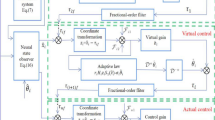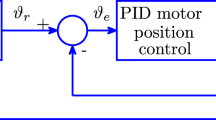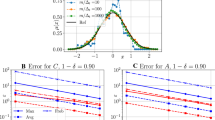Abstract
When a feedback system has components described by non-rational transfer functions, a standard practice in designing such a system is to replace the non-rational functions with rational approximants and then carry out the design with the approximants by means of a method that copes with rational systems. In order to ensure that the design carried out with the approximants still provides satisfactory results for the original system, a criterion of approximation should be explicitly taken into account in the design formulation. This paper derives such a criterion for multi-input multi-output (MIMO) feedback systems whose design objective is to ensure that the absolute values of every error and every controller output components always stay within prescribed bounds whenever the inputs satisfy certain bounding conditions. The obtained criterion generalizes a known result which was derived for single-input single-output (SISO) systems; furthermore, for a given rational approximant matrix, it is expressed as a set of inequalities that can be solved in practice. Finally, a controller for a binary distillation column is designed by using the criterion in conjunction with the method of inequalities. The numerical results clearly demonstrate that the usefulness of the criterion in obtaining a design solution for the original system.
Similar content being viewed by others
References
B. J. Birch, R. Jackson. The behaviour of linear systems with inputs satisfying certain bounding conditions. Journal of Electronics and Control, vol. 6, no. 4, pp. 366–375, 1959.
V. Zakian. New formulation for the method of inequalities. Proceedings of the Institution of Electrical Engineers, vol. 126, no. 6, pp. 579–584, 1979. (Reprinted in Systems and Control Encyclopedia, vol. 5, pp. 3206–3215, 1987.)
V. Zakian. A criterion of approximation for the method of inequalities. International Journal of Control, vol. 37, no. 5, pp. 1103–1111, 1983.
V. Zakian. A Framework for Design: Theory of Majorants. Control Systems Centre Report No. 604, University of Manchester Institute of Science and Technology, Manchester, UK, 1984.
V. Zakian. A performance criterion. International Journal of Control, vol. 43, no. 3, pp. 921–931, 1986.
V. Zakian. Perspectives on the principle of matching and the method of inequalities. International Journal of Control, vol. 65, no. 1, pp. 147–175, 1996.
V. Zakian. Control Systems Design: A New Framework, London, UK: Springer-Verlag, 2005.
P. G. Lane. The principle of matching: A necessary and sufficient condition for inputs restricted in magnitude and rate of change. International Journal of Control, vol. 62, no. 4, pp. 893–915, 1995.
W. Silpsrikul, S. Arunsawatwong. Computation of peak output for inputs restricted in L2 and L8 norms using finite difference schemes and convex optimization. International Journal of Automation and Computing, vol. 6, no. 1, pp. 7–13, 2009.
W. Silpsrikul, S. Arunsawatwong. Computation of peak output for inputs satisfying many bounding conditions on magnitude and slope. International Journal of Control, vol. 83, no. 1, pp. 49–65, 2010.
S. Arunsawatwong. Stability of retarded delay differential systems. International Journal of Control, vol. 65, no. 2, pp. 347–364, 1996.
S. Arunsawatwong. Stability of Zakian IMN recursions for linear delay differential equations. BIT Numerical Mathematics, vol. 38, no. 2, pp. 219–233, 1998.
S. Arunsawatwong, Q. Van Nguyen. Design of retarded fractional delay differential systems using the method of inequalities. International Journal of Automation and Computing, vol. 6, no. 1, pp. 22–28, 2009.
W. Silpsrikul, S. Arunsawatwong. Design of fractional PI controllers for a binary distillation column with disturbances restricted in magnitude and slope. In Proceedings of the 18th IFAC World Congress, IFAC, Milan, Italy, pp. 7702–7707, 2011.
A. T. Bada. Design of delayed control systems with Zakian’s method. International Journal of Control, vol. 40, no. 4, pp. 773–781, 1984.
A. T. Bada. Design of delayed control systems using Zakian’s framework. Proceedings of the Institution of Electrical Engineers, vol. 132, no. 6, pp. 251–256, 1985.
A. T. Bada. Robust brake control for a heavy-duty truck. Proceedings of the Institution of Electrical Engineers, vol. 134, no. 1, pp. 1–8, 1987.
O. Taiwo. The design of robust control systems for plants with recycle. International Journal of Control, vol. 43, no. 2, pp. 671–678, 1986.
V. S. Mai, S. Arunsawatwong, E. H. Abed. Design of uncertain nonlinear feedback systems with inputs and outputs satisfying bounding conditions. In Proceedings of the 18th IFACWorld Congress, IFAC, Milan, Italy, pp. 10970–10975, 2011.
H. H. Nguyen, S. Arunsawatwong. Robust controller design for feedback systems with uncertain backlash and plant uncertainties subject to inputs satisfying bounding conditions. In Proceedings of the 19th IFAC World Congress, IFAC, Cape Town, South Africa, pp. 1643–1648, 2014.
T. Chuman, S. Arunsawatwong. Criterion of approximation for designing 2 × 2 feedback systems with inputs satisfying bounding conditions. In Proceedings of the 11th International Conference on Electrical Engineering/Electronics, Computer, Telecommunications and Information Technology, IEEE, Nakhon Ratchasima, Thailand, pp. 1–6, 2014.
S. Arunsawatwong. Critical control of building under seismic disturbance. Control Systems Design: A New Framework, V. Zakian, Ed., London, UK: Springer-Verlag, pp. 339–353, 2005.
V. Zakian, U. Al-Naib. Design of dynamical and control systems by the method of inequalities. Proceedings of the Institution of Electrical Engineers, vol. 120, no. 11, pp. 1421–1427, 1973.
A. Berman, R. J. Plemmons. Nonnegative Matrices in the Mathematical Sciences, New York, USA: Academic Press, 1979.
S. Barnett. Matrices: Methods and Applications, Oxford, UK: Oxford University Press, 1990.
C. A. Desoer, M. Vidyasagar. Feedback Systems: Input-Output Properties, New York, USA: Academic Press, 1975.
R. K. Wood, M. W. Berry. Terminal composition control of a binary distillation column. Chemical Engineering Science, vol. 28, no. 9, pp. 1707–1717, 1973.
G. A. Baker, P. Graves-Morris. Padé Approximants, New York, USA: Cambridge University Press, 1996.
R. Curtain, K. Morris. Transfer functions of distributed parameter systems: A tutorial. Automatica, vol. 45, no. 5, pp. 1101–1116, 2009.
Acknowledgments
T. Chuman gratefully acknowledges the financial support from the honour program of the Department of Electrical Engineering, Faculty of Engineering, Chulalongkorn University.
Author information
Authors and Affiliations
Corresponding author
Additional information
Recommended by Associate Editor James Whidborne
Suchin Arunsawatwong received the B.Eng. and M.Eng. degrees in electrical engineering from Chulalongkorn University, Thailand in 1985 and 1988, respectively, and Ph.D. degree in control engineering from the Control Systems Centre, University of Manchester Institute of Science and Technology, UK in 1995. He is currently an assistant professor at the Department of Electrical Engineering, Chulalongkorn University.
His research interests include control systems design by the method of inequalities and the principle of matching, delay differential systems, fractional-order control systems, numerical solution of differential equations and power systems control.
ORCID iD: 0000-0002-7467-9429
Tadchanon Chuman received the B.Eng. and M.Eng. degrees in electrical engineering from Chulalongkorn University, Thailand in 2012 and 2014, respectively. He is currently a Ph. D. degree candidate at Control Systems Research Laboratory, the Department of Electrical Engineering, Chulalongkorn University.
His research interests include control systems design using the method of inequalities and the principle of matching, control systems with saturation, and load frequency control.
Rights and permissions
About this article
Cite this article
Arunsawatwong, S., Chuman, T. Design of non-rational MIMO feedback systems with inputs and outputs satisfying certain bounding conditions by using rational approximants. Int. J. Autom. Comput. 14, 360–370 (2017). https://doi.org/10.1007/s11633-016-0991-5
Received:
Accepted:
Published:
Issue Date:
DOI: https://doi.org/10.1007/s11633-016-0991-5




